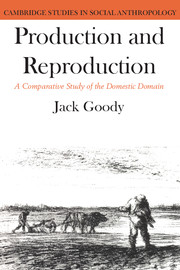Book contents
- Frontmatter
- Contents
- Tables
- Figures
- Preface
- Acknowledgements
- 1 The evolution of the domestic economy: the hoe and the plough
- 2 The theory, the variables and a test
- 3 Making causal inferences
- 4 Farming, labour and sex
- 5 Concubines and co-wives: the structure of roles in Africa and Eurasia
- 6 Adoption in cross-cultural perspective
- 7 Strategies of heirship
- 8 Class and marriage
- 9 Retrospect
- Appendix 1 Tables
- Appendix 2 The probability of family distributions
- Notes
- References
- Index
5 - Concubines and co-wives: the structure of roles in Africa and Eurasia
Published online by Cambridge University Press: 05 June 2012
- Frontmatter
- Contents
- Tables
- Figures
- Preface
- Acknowledgements
- 1 The evolution of the domestic economy: the hoe and the plough
- 2 The theory, the variables and a test
- 3 Making causal inferences
- 4 Farming, labour and sex
- 5 Concubines and co-wives: the structure of roles in Africa and Eurasia
- 6 Adoption in cross-cultural perspective
- 7 Strategies of heirship
- 8 Class and marriage
- 9 Retrospect
- Appendix 1 Tables
- Appendix 2 The probability of family distributions
- Notes
- References
- Index
Summary
The phrase ‘social structure’ has carried a variety of different meanings, but the one with which I want to start is that used by Nadel in his Theory of Social Structure. Nadel attempted to outline a mode of analysing and comparing the inventory (or ‘set’) of roles in human societies, giving special attention to differences in the command over actions and command over resources (1957, 115). His analysis has not to my knowledge been pursued, nor do I intend to do so here, though not for lack of faith. My intention is more concrete, for it is to look at certain aspects of the structure of roles not only as a ‘set’ (i.e. from the internal standpoint) but in order to examine their articulation with other aspects of the social system (the external standpoint) as well as their implications for individual behaviour (the internalised standpoint). I do not wish to go into the merits of different approaches, structural or functional, to the study of society, since I do not think of these as alternatives. But I would suggest that we must try to get beyond the more simple-minded complexity of most writing in this area and try to link our efforts to the mainstream of social and historical thought, a not unimportant consideration for those who hope for cumulative advances in the social sciences.
- Type
- Chapter
- Information
- Production and ReproductionA Comparative Study of the Domestic Domain, pp. 41 - 65Publisher: Cambridge University PressPrint publication year: 1977

